

This week, more news of the BIFGA Technical Day - far too much to report on in full detail, but a flavour of the excellent presentations in this years event.
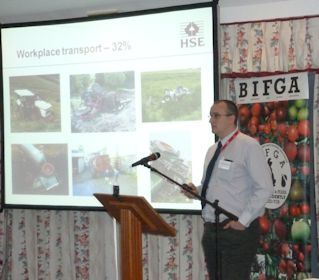 Opening the presentations - Mike Walters, Senior HM Inspector HSE gave an overview of accidents in the Horticulture sector. He operates of team of 7.5 (full time equivalents) inspectors; their role is now a reactive one rather than the proactive one used in the past. No longer do they make speculative visits; the Inspectors only visit if an accident has occurred!
Opening the presentations - Mike Walters, Senior HM Inspector HSE gave an overview of accidents in the Horticulture sector. He operates of team of 7.5 (full time equivalents) inspectors; their role is now a reactive one rather than the proactive one used in the past. No longer do they make speculative visits; the Inspectors only visit if an accident has occurred!
Agriculture (that takes in all sectors) has one of the worst accident performances, averaging 'one death per week, almost all of which are preventable. While agriculture employs only 1.5% of the UK workforce, 15 - 20% of fatal accidents occur in the agricultural sector.
In the useful HSE Guide, 'reducing risk' is illustrated by taking proactive measures. Overhead cables are responsible for many accidents - relaying them underground eliminates the risk; PTO's (Power Take Off) are 'killers' and often the cost of avoiding an accident can be measured in 'pence' as the nylon bearing rings which keep the protective cover running free from the PTO shaft are the difference between serious injury (limbs torn off) and safety.
Below - a passage from the HSE Guide which can be found on the HSE website www.hse.gov.uk Click on 'Risk Assesment - A Brief Guide'
"Generally, you need to do everything 'reasonably practicable' to protect people from harm. This means balancing the level of risk against the measures needed to control the real risk in terms of money, time or trouble. However, you do not need to take action if it would be grossly disproportionate to the level of risk".
Simon Townsend - BASF - New Innovations
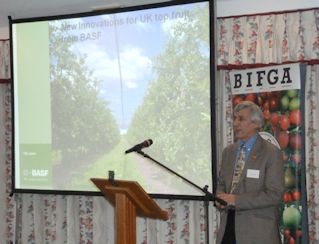 Simon reminded BIFGA members that it costs £200 million to develop a new protectant from research to the point of general use. Simon gave an overview of new innovations available to BASF protectants; innovations that improve the efficacy of the protectant; for example REGALIS Plus which has a built in water conditioner allowing a faster uptake by the leaf. This is important as REGALIS is designed as a 'growth control' material keeping unwanted vigour in hand and improving the potential crop.
Simon reminded BIFGA members that it costs £200 million to develop a new protectant from research to the point of general use. Simon gave an overview of new innovations available to BASF protectants; innovations that improve the efficacy of the protectant; for example REGALIS Plus which has a built in water conditioner allowing a faster uptake by the leaf. This is important as REGALIS is designed as a 'growth control' material keeping unwanted vigour in hand and improving the potential crop.
Nemasys® C - Contains the beneficial nematode Steinernema carpocapsae (87%) and an inert carrier with water (13%) for Codling moth (Cydia pomonella) control at the 5th instar (overwintering stage) on top fruit; Nematodes are not harmful to fish, birds or wildlife and can be sprayed onto trees.
Nemasys® C used in conjunction with pheremone mating disruptors to control Codling Moth are a non pesticide way forward; by hanging capsules in the orchard deigned to release the pheromone over a 9 month period control has been effective in trials carried out by Simon.
See The English Apple Man Journal for 22nd August 2014
Tom House - Hutchinsons
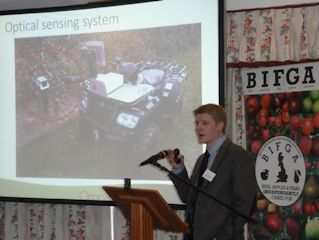 Tom studied at Harper Adams and is now part of the team at H.L.Hutchinson responsible for delivering OMNIA technology to farmers and fruit growers.
Tom studied at Harper Adams and is now part of the team at H.L.Hutchinson responsible for delivering OMNIA technology to farmers and fruit growers.
In the link below - the equipment used can be seen working in an apple orchard.
The OMNIA Fruit Vision Technology should transform the estimation of apple yields; The camera identifies each fruit and 'digitally records' the characteristics of each fruit onto a database which enables farm management to make intelligent and informed decisions.
Tom told the audience the system incorporates a highest specification - 'Ruggedised PC' (strong build) GPS locator with XYZ coordinate capability, taking 20 images a second while travelling at 6 - 8 km per hour. Tom said that on Braeburn in last years trials the system proved 95% accurate; the equipment has been calibrated to work on Jazz, Amelia, Braeburn, Rubens, Dabinette.
The 'mark 2' version will measure fruit into size bands, shape and able to overlay yield and soil maps enabling detailed analysis of the 'why and wherefores' of orchard performance.
Final product specification will be in place by June 2015 and limited availability for orchard assessments in August 2015. Tom said full commercial availability will be in place in 2016.
Hutchinsons have exclusivity over OMNIA Products.
Scott Raffle - HDC (Horticultural Development Company)
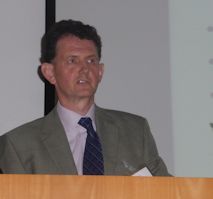 Scott gave an update of HDC sponsored LINK projects.
Scott gave an update of HDC sponsored LINK projects.
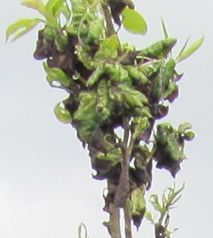 Pear Sucker is one of the most challenging pests affecting pear production; Scott demonstrated the beneficial predators - anthocorids and earwigs and their natural habitats; Willow, Hawthorn, Hazel and Nettle. Maintaining habitats (networks of hedgerows) and 'avoiding broad spectrum insecticides' is vital to developing beneficial predators.
Pear Sucker is one of the most challenging pests affecting pear production; Scott demonstrated the beneficial predators - anthocorids and earwigs and their natural habitats; Willow, Hawthorn, Hazel and Nettle. Maintaining habitats (networks of hedgerows) and 'avoiding broad spectrum insecticides' is vital to developing beneficial predators.
One of the most challenging (important) pests faced by our Cherry growers is Spotted Wing Drosophila (SWD), which originated in Asia, and can now be found worldwide. It arrived in Southern Europe in 2008 before being recorded in small numbers in the UK in August 2012.
During the 2014 UK cherry harvest, SWD appeared in some orchards with devastating effect. HDC planning started in 2010 and an SWD 'working group formed in 2012. Experience from other countries where SWD is prevalent indicates that the following fruit crops are particularly vulnerable: blackberry, blackcurrant, blueberry, cherry, fig, kiwi fruit, nectarine, peach, plum, raspberry, redcurrant, strawberry and table grapes.
In the UK cherry growers are particularly apprehensive about the appearance of SWD here.
EAM readers concerned about SWD should take a look at the HDC website which is open to anyone by clicking on; Horticultural Development Company where a comprehensive account of SWD and other HDC - LINK project information can be accessed.
Angela Berrie - EMR - Research Leader, Plant Pathologist
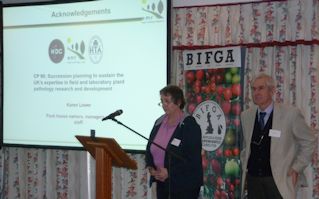 Angela who joined EMR in 1993 is now 'semi retired' but still a very active member of the research team; her subject - 'avoiding rotten apples' depends on the 'Cultivar - Season - Orchard - Storage and Length of Storage factors factors. To combat rotten apples we need to know what rots we are dealing with!
Angela who joined EMR in 1993 is now 'semi retired' but still a very active member of the research team; her subject - 'avoiding rotten apples' depends on the 'Cultivar - Season - Orchard - Storage and Length of Storage factors factors. To combat rotten apples we need to know what rots we are dealing with!
Many factors influence rotten apples - in addition to the factors listed, aspects like 'Bin Hygiene' contribute to rots.
Help is at hand - The HDC - DVD 'Mastering rot risk assessment' is a valuable tool in the evaluation of specific rots on a particular farm. Angela said the period of rot surveys covers 80 years. In the 1930's apples were 'Barn Stored' in the 1960's 'Cold Stored' and in the 1980's 'Cox & Bramley' constituted most of the tonnage in stores.
Jerry Cross - EMR - Pest & Pathogen Ecology for Sustainable Crop Management
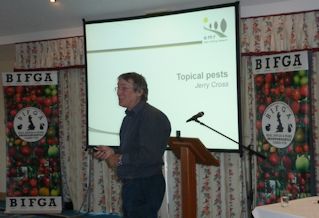 Jerry is an Entomologist and pesticide application specialist.
Jerry is an Entomologist and pesticide application specialist.
Jerry opened his presentation with an update on Rhynchites Weevil; they can be found on their 'hosts' Hawthorn and Blackthorn - but during and after apple blossom they lay one egg in a fruit, then bite into the stalk causing it to sever and fall to the ground where it overwinters on the orchard floor. All orchards are at risk - spraying Calypso at petal fall is the recommended treatment, but timing is critical; after flowering is complete it is too late!
To view a broader overview of Rhyncites Weevil click on English Apple Man Journal for 9th May 2014
Stink Bugs
 The brown marmorated stink bug (BMSB), Halyomorpha halys is an Asian species, not to be confused with Palomena prasina - the Common Green Shieldbug - Family: Pentatomidae.
The brown marmorated stink bug (BMSB), Halyomorpha halys is an Asian species, not to be confused with Palomena prasina - the Common Green Shieldbug - Family: Pentatomidae.
Stink Bug (BMSB) damage has become a big problem in Holland; The stink bug derives its name from its tendency to eject a foul smelling glandular substance secreted from pores in the thorax when disturbed.
BMSB is native to Eastern Asia, mainly China, Korea, Japan, and Taiwan.
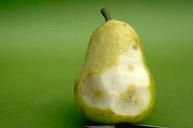 The species is native to Asia and was introduced into the United States in the mid-1990s, possibly stowing away in a shipping container. Their numbers and range have been growing since that time, and they have proved difficult to manage.
The species is native to Asia and was introduced into the United States in the mid-1990s, possibly stowing away in a shipping container. Their numbers and range have been growing since that time, and they have proved difficult to manage.
In the USA - While tree fruits are the primary crops of concern, this species has also been observed to feed successfully on numerous fruit and vegetable crops including apples, apricots, Asian pears, cherries, corn (field and sweet), grapes, lima beans, nectarines and peaches, peppers, tomatoes and soybeans.
Physical damage includes pitting and scarring, sometimes leading to a mealy texture in the fruit.
SWD
 Returning to the subject of SWD, Jerry said it can be controlled IF you do things right!
Returning to the subject of SWD, Jerry said it can be controlled IF you do things right!
Cherries are very susceptible; the mild winter of 2013/14 resulted in the SWD population never becoming fully dormant. The first eggs were laid on 29th May; Adult SWD monitoring traps are not a reliable predictor of crop attack on Cherry.
Tracer is the best option for control; SWD like Ivy and trees in Woodland and Leaf litter. In Asia a Parasitic Wasp is the natural predator.
Answering a question suggesting netting might be a defence against SWD (netting is being used in some countries to stop the invasion of insects and reduce the need for insecticides) Jerry said the net would need to be very fine as the SWD can pass through a hole 0.7mm in size.
The 2015 BIFGA Technical Day was once again a great success; it cannot be easy for the BIFGA committee; Chairman John Breach and BIFGA Secretary Judi Perry to construct a programme each year of such high quality, but once again they succeeded!
That's all for this week; next week The English Apple Man reports on the Huxley Pruning Day at Hadlow College........
Take care
The English Apple Man